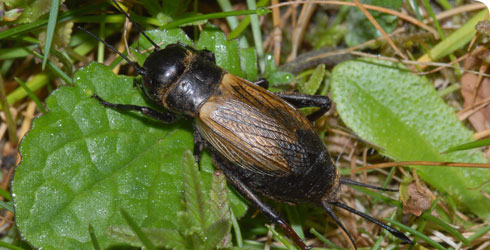Conservation
English Nature launched a Species Recovery Programme for the field cricket, Gryllus campestris, in 1991.
A captive-breeding programme was established by taking pairs from the well-established Coates Castle site, and rearing their progeny in special enclosures at London Zoo. This programme was suspended in 2006 as gregarine gut parasites (which are naturally occurring) were discovered in the culture. However, translocation of specimens from existing sites has been practiced, with considerable success.
The survival of this species is known to be dependant on appropriate vegetation structure, resulting from cyclical disturbance of the habitat. Overgrowth of bracken, bramble and young trees must be removed, mechanically or preferably by cattle grazing.
The continuing success and spread of the field cricket at current sites in southern England is only possible through the joint efforts of landowners and other interested parties, together with Natural England (formerly English Nature) and the Species Recovery Programme.
The success of specimen translocation has recently been documented in northern Europe (Hochkirch, 1996, Kleukers et al., 1997) where the oligotrophic grassland and heathland habitats of the field cricket have become rare and fragmented. This process was accelerated by changes in land use. Sheep herding ceased at the end of the 19th century, reducing the possibility of cricket dispersal along herding routes (Lütkepohl 2001).
Studies of translocation and natural populations of G. campestris in Germany (Witzenberger and Hochkirch, 2008) have shown that translocation does not result in a significant loss of genetic diversity. Translocation of nymphs from different subpopulations may in fact be a suitable method to decrease the loss of genetic diversity and reduce the risk of inbreeding, and large numbers of nymphs may be translocated without negative effect on the source population.
Toolbox
Glossary
Oligotrophic
Lacking or restricted to a narrow range of nutrients.
Translocation
The movement (by humans) of a species to an entirely new area.
